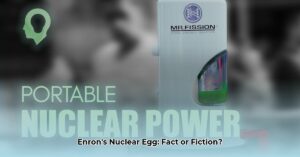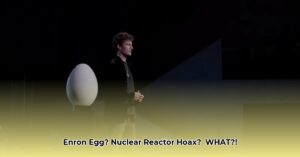The year is 2025. Enron, the poster child for corporate malfeasance, rises from the ashes of scandal… to sell us eggs? Not just any eggs, mind you, but nuclear-powered eggs. The “Enron Egg Micro Nuclear Reactor,” a sleek, egg-shaped device promising to solve the energy crisis, seemed too good to be true. And it was. This wasn’t a product launch; it was a meticulously crafted satire, a darkly comedic commentary on corporate greed, public anxieties, and the seductive allure of technological quick fixes. Let’s crack open this viral hoax and see what makes it tick.
From Scandal to Satire: The Egg’s Genesis
The Enron Egg wasn’t hatched overnight. It’s the brainchild of Connor Gaydos, the mastermind behind the “Birds Aren’t Real” movement. Having already established his expertise in absurdist internet satire, Gaydos acquired the rights to the Enron name, a brand synonymous with corporate deception, and repurposed it for this project. The choice is both audacious and strategic, tapping into a well of collective distrust and cynicism towards corporate America.
The “Egg” itself, presented in a stylized marketing video, is a masterpiece of deceptive design. It’s sleek, modern, and packed with just enough technical jargon – “3D-printed Inconel heat exchangers,” “Uranium-Zirconium Hydride (U-ZrH) fuel rods” – to sound vaguely plausible to the non-nuclear physicist. The website, Enron.com, furthered the illusion, offering detailed (and entirely fabricated) specifications and even merchandise. Yes, you could buy an Enron Egg t-shirt, a tangible piece of an intangible product. The irony is palpable.
Decoding the Yolk: What’s the Point?
The Enron Egg wasn’t designed to power homes; it was designed to spark conversation. It’s a satirical jab at corporate hubris, the often-outlandish promises made in the name of innovation, and our own anxieties about the future of energy. The egg imagery itself is layered with meaning. It suggests fragility, the precariousness of our energy systems; potential, the allure of technological solutions; and, of course, the possibility of something rotten lurking beneath a pristine shell, a clear nod to Enron’s scandalous past.
Some theories suggest the campaign is a publicity stunt, a cynical attempt to rehabilitate the Enron brand. This perspective suggests the creators might be aiming to reintroduce Enron into the public consciousness, leveraging the notoriety of their past for a fresh start. However, given Gaydos’s history with “Birds Aren’t Real,” it’s more likely a commentary on corporate greed, misplaced trust, and perhaps even a reflection of our own desire for simple solutions to complex problems. The Enron Egg forces us to confront uncomfortable questions: Are we too easily seduced by technological promises, even when they come from dubious sources? Do we place too much faith in the pronouncements of powerful entities, even those with a history of deception?
The Scramble: Public Reaction and Media Coverage
The Enron Egg didn’t lay dormant for long. It quickly hatched into a viral sensation, cracking open a Pandora’s Box of reactions. Confusion reigned supreme. Was this real? Could Enron actually be selling miniature nuclear reactors? News outlets scrambled to debunk the hoax, inadvertently fueling its spread. The internet, as it tends to do, erupted in memes, jokes, and heated debates. The Enron Egg, fake as it was, became a cultural touchstone, a symbol of our complicated relationship with technology, corporations, and the information we consume in the digital age.
This raises the question: How much credence should we give to information online? The egg also functions as an important reminder of the power of satire in our society. Through humor and parody, the Enron Egg campaign challenges conventional ideas about corporate behavior and the energy crisis, prompting us to reconsider our assumptions about both. This approach can be more engaging and impactful than traditional forms of criticism, as it encourages dialogue and discussion in a less confrontational manner.
The Shell Game: Enron’s Bizarre Transformation
From disgraced energy giant to purveyor of satirical hoaxes, Enron’s transformation is nothing short of bizarre. Is it an attempt at redemption? A cynical marketing ploy? Or simply a testament to the power of irony in the digital age? It’s hard to say for sure. What is clear is that the Enron Egg, while undeniably fake, has laid bare some important truths about our society. It reminds us to be skeptical, to question the narratives presented to us, and to approach grand promises with a healthy dose of caution. Perhaps, in the end, the greatest power of the Enron Egg lies not in its fictional technology, but in its ability to make us think, to question, and maybe, just maybe, to laugh at ourselves in the process.
| Feature | Enron Egg (Satire) | Real-World Small Modular Reactors (SMRs) |
|---|---|---|
| Size | Egg-sized | Much larger, industrial scale |
| Power Output | Powers a home (fictionally) | Significantly higher power output |
| Technology | Fictional | Based on existing and developing nuclear technologies |
| Cost | Unspecified | Expected to be substantial |
| Availability | Non-existent | Still in development and deployment phases |
The Enron Egg may not be a nuclear reactor, but it has certainly generated a nuclear-sized reaction. It’s a potent reminder that in the age of misinformation, satire can be a powerful tool for social commentary, prompting us to question everything, even the most seemingly innocuous of objects. Maybe the real power isn’t in splitting atoms, but in cracking open the shell of deception and confronting the absurdities of our world.







